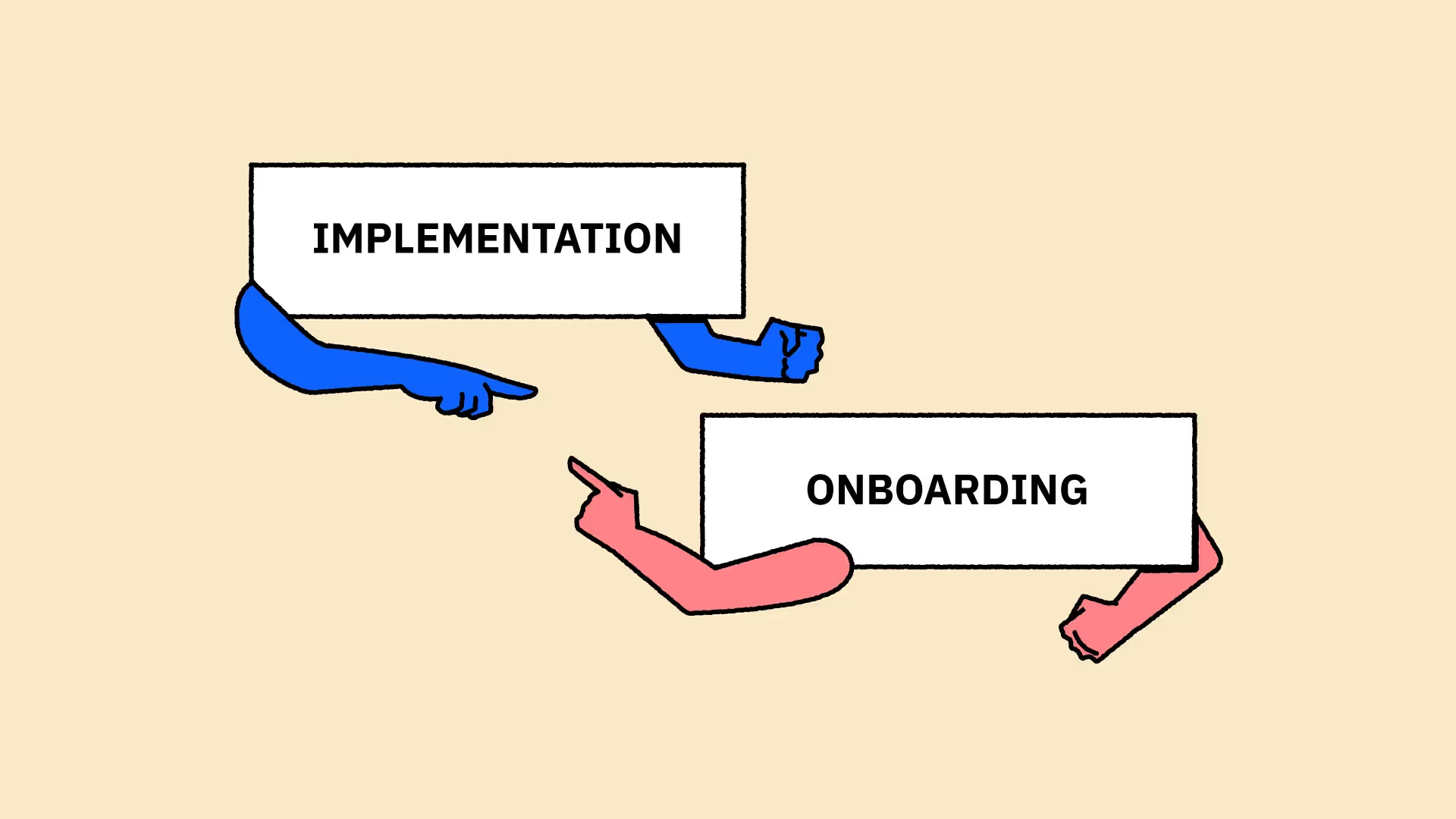In this Preflight Conversation, we explore the definitions of implementation and onboarding, what they are, and how the roles within implementation and onboarding functions change with the business size, product, ICP, and other variables.
Implementation is a subset of customer onboarding. While implementation deals with the more technical aspect, onboarding is everything from the kickoff activities to training, adoption, etc. It is much more than just completing the implementation.
We talk about the various hats people don and the emerging differences in how experts are defining implementation and onboarding. We keep in mind that implementation has traditionally been the technical part of the journey, whereas onboarding is the superset.
Organizations have experienced the benefits of collaboration and are now proactively giving their employees avenues for repetitive cross-functional collaboration. This means that roles must be well-defined with high accountability while allowing the space and freedom to do what is best for the customer.
In this conversation, Preflighters discussed whether this nuanced definition brings clarity and helps them communicate better to internal and external stakeholders or if it hurts the objectives and customer goals.
How do organizations think about onboarding and implementation now?
Jeff Kushmerek, CEO & Founder - Infinite Renewals
Implementation and onboarding can be used interchangeably in most circumstances. Using different terminology and definitions for implementation and onboarding could confuse your customers. If your customers are confused, it leads to delaying or derailing organizational goals.
A few consequences when an organization is faced with the situation of building great walls around the definitions of these terms are:
- Confused customers: The customer might not understand the nuance of each rigid boundary set for a team member. They are in the dark about how processes have been set internally.
- Lack of accountability: Large enterprises can afford separate implementation and onboarding teams, but smaller companies cannot. Individuals in each team can strictly stick to their scope of work in larger companies. Startups shouldn't fall prey to doing this early on in their journey. An individual from any team having to tell a customer that "they're not the right person for this" shows a lack of accountability and reflects poorly on the customer's journey. It doesn't help to have early teams form the theoretical divide in their minds.
- Rigid definitions also mean you can’t be accommodative of the complexity of the product you sell, the size of the company, your client and their business, etc.
Kristine Kukich, Senior Director of Customer Marketing - Thought Industries
Thought Industries is a startup. We’re a lean team; everyone is wearing different hats. We have a continuous set of goals to get the customer to the point of value. We might not delineate the differences between onboarding, customer education, and the scope of implementation services.
I see all of these as a fabric. I see these teams working together and weaving into the fabric until our customer derives value. We function in a way that we can set simultaneous goals instead of sprints and handovers from team to team. This process makes the most sense for the customer to consciously consume and see for themselves the success they are achieving with our offerings.
Does semantics have anything to do with your team's success?
Sri Ganesan, CEO & Co-founder - Rocketlane
I want to draw attention to how teams perceive what they are called and how this influences their outcomes. Let us think implementation team vs. the value delivery team. The latter sets a clear goal without setting any rigid boundaries. The mission here is clear, and you do what is required to get to first value for your customers.
People have been implementing software for ages; startups usually have one person doing the solutions, demos, and juggling everything else. Initially, the path is laid from solutions to the customers' needs, bottlenecks in adoption, and other ad hoc requests.
Attitude changes in a team are not easy to bring about. These semantics might take you a step closer to higher accountability and ownership.
Jeff Kushmerek, CEO & Founder - Infinite Renewals
Most enterprise setups start with a joint success plan at the very beginning. The earlier, the better. We're talking as early as pre-sales or latest, during the kickoff. This practice works well for companies of all sizes.
In some companies, the account can be handed over to the CSMs only after the value/goal has been achieved. They cannot transition or hand over an account before achieving these goals. This makes the onboarding process whole. It is then up to the CSMs to ensure they are referencing the value and looking at what more can be done for the customer.
There shouldn't be any confusion over the semantics because it does not solve anything for your customers.
Megan Holbrook, Client Success Manager - Realync
At Realnyc, we are a team of ten. Half of the team handles the behind-the-scenes tasks like account setup. We have realized that implementation is the face of our client service.
We have reached a point where we needed the process to be a little more spread out. One of our client success managers is now our implementation manager. She will be responsible for designing the process. She has set up a process where the 45 days will include meeting with the client's team and the initial counsel, bringing in the client success manager to transition the account, etc.
The continuity of one person doing onboarding and implementation is helpful to the client. I was skeptical of this approach at first, but having one person handle the journey is unrealistic and unscalable.
Vaibhav Mittal, Bioinformatics Onboarding - Elucidata
We take an all-hands-on-deck approach. The CS team is responsible for ensuring:
- Proper handover from sales happens
- Customers are live
- Customers derive value
- A professional services component in the project is associated with the first value
- Project deadlines and communications are in sync
We are a biomedical data company. Our implementations are pretty technical. As we grow, it would help to have people specialists handle the implementation gradually.
What works and what does not?
There are organizations out there that have a CSM team managing existing customers. Two new members are added to the team every quarter from onboarding and implementation, where they already have sound product knowledge. This acts as the launch pad for these new CSMs. From a CSM perspective, all the customers onboarded from that quarter become their book of account.
If you're selling to a multi-million dollar customer, that model doesn't work. Junior resources cannot be expected to do a renewal or an upsell for accounts that bring in an ARR upwards of $200K or $500K.
Sometimes when an account gets too large, the CSMs’ role stops at renewal. The account is handed to a key account manager or renewal manager. These teams could report to sales, CS, or BD.
Different models are needed to meet the customer's requirements based on what the company is doing, product offerings, the companies your products are built for, the markets your customers operate in, and other variables. One size does not fit all!
Closing Notes
There are so many variables while setting processes that onboarding and implementation need to evolve as your organization evolves.
Pay cautious attention, so you don’t fall into the trap of mismatched expectations. Here is how:
- Start by drawing out a joint success plan
- Stay on the course when perceived needs are confused with actual requirements
- Tie up loose ends consistently throughout the customer journey
- Allot time to coordinate and realign goals during handovers
- Do not confuse your customers with multiple points of contact for closely related problems
- Have a central control tower. A person or team your customers can contact for any all quires.
In sum, the definition of implementation and onboarding will evolve with the changes in how we operate. These definitions will be impacted by how organizations prioritize and retain customer centricity and employee well-being, and cross-organizational collaboration happens.
If you have any thoughts you want to share, we’d love to have you join Preflight Community and share them with our members!
Further reading
- Client onboarding is an ever-changing process. Keep yourself updated with our 2023 client onboarding guide.
- Wondering what customer onboarding entails? Let us demystify the process for you.
- Don’t let common customer onboarding challenges derail things. Our guide has the solutions you need.
- Need a quick overview of what you need to do during client onboarding? Use this client onboarding checklist!






















.webp)
